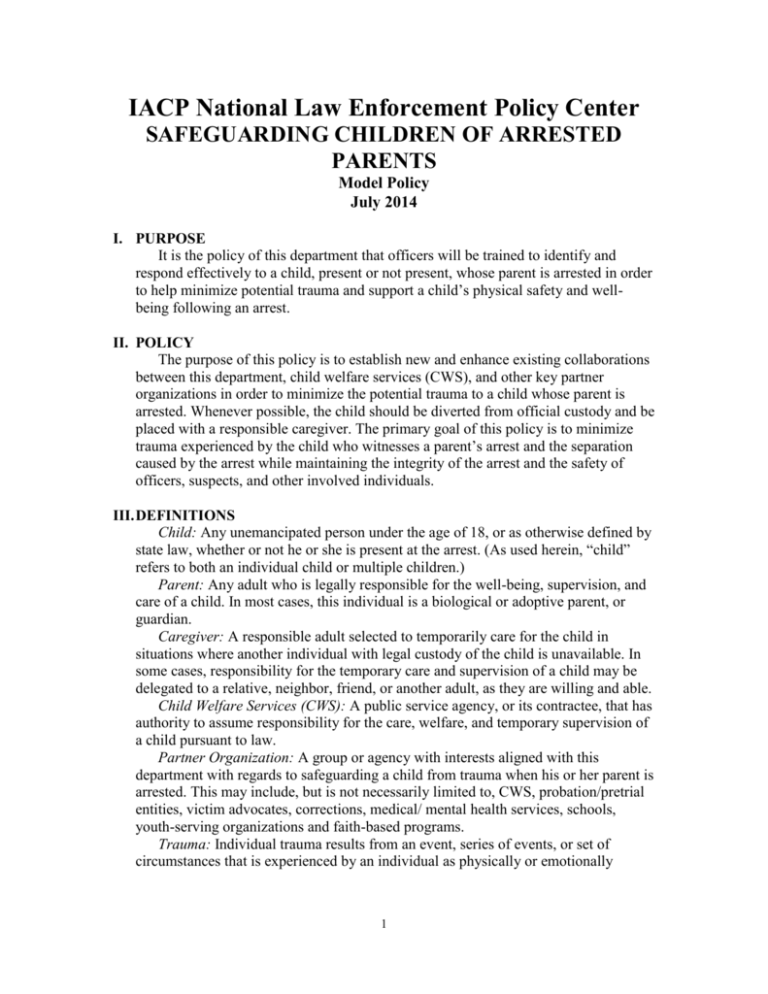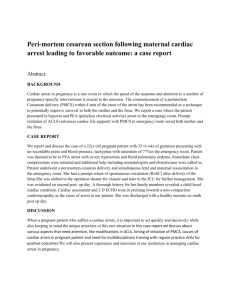Safeguarding Children of Arrested Parents Model Policy.
advertisement

IACP National Law Enforcement Policy Center SAFEGUARDING CHILDREN OF ARRESTED PARENTS Model Policy July 2014 I. PURPOSE It is the policy of this department that officers will be trained to identify and respond effectively to a child, present or not present, whose parent is arrested in order to help minimize potential trauma and support a child’s physical safety and wellbeing following an arrest. II. POLICY The purpose of this policy is to establish new and enhance existing collaborations between this department, child welfare services (CWS), and other key partner organizations in order to minimize the potential trauma to a child whose parent is arrested. Whenever possible, the child should be diverted from official custody and be placed with a responsible caregiver. The primary goal of this policy is to minimize trauma experienced by the child who witnesses a parent’s arrest and the separation caused by the arrest while maintaining the integrity of the arrest and the safety of officers, suspects, and other involved individuals. III. DEFINITIONS Child: Any unemancipated person under the age of 18, or as otherwise defined by state law, whether or not he or she is present at the arrest. (As used herein, “child” refers to both an individual child or multiple children.) Parent: Any adult who is legally responsible for the well-being, supervision, and care of a child. In most cases, this individual is a biological or adoptive parent, or guardian. Caregiver: A responsible adult selected to temporarily care for the child in situations where another individual with legal custody of the child is unavailable. In some cases, responsibility for the temporary care and supervision of a child may be delegated to a relative, neighbor, friend, or another adult, as they are willing and able. Child Welfare Services (CWS): A public service agency, or its contractee, that has authority to assume responsibility for the care, welfare, and temporary supervision of a child pursuant to law. Partner Organization: A group or agency with interests aligned with this department with regards to safeguarding a child from trauma when his or her parent is arrested. This may include, but is not necessarily limited to, CWS, probation/pretrial entities, victim advocates, corrections, medical/ mental health services, schools, youth-serving organizations and faith-based programs. Trauma: Individual trauma results from an event, series of events, or set of circumstances that is experienced by an individual as physically or emotionally 1 harmful or threatening and that has lasting adverse effects on the individual’s functioning and physical, mental, social, emotional, or spiritual well-being. Responsible Adult: An individual over 18 years of age who can pass a preliminary NCIC check and clear a child protection registry background check to ensure that he/she does not have any arrests for founded cases of child abuse, sexual crimes, domestic violence, recent arrests for drug use or possession, or other violent felony violations. IV. PROCEDURES A. Chief Executive Responsibilities 1. Agency Coordination a. This department shall have a cooperative agreement with CWS and partner organizations that can provide on-site and other assistance to law enforcement requests for assistance when a child’s parent is arrested. b. Regular meetings shall be held involving all partner organizations to review and evaluate the effectiveness of joint operational protocols and to make improvements where necessary. c. The department’s chief executive shall designate a liaison who is responsible for ensuring that follow-up is conducted to support the well-being of the child of an arrested parent. d. Officers shall be provided with a list of agencies that have partnered under the cooperative agreement, along with contact information for each. These agencies may be contacted by the arresting officer, or another component of this department, when officers need assistance during the arrest of a parent. 2. Training a. Officers of this department shall be trained to effectively communicate with the child using developmentally appropriate language during a parental arrest. b. This department shall provide recruit training and routine inservice training on child development and the effects of trauma on the child so that officers can effectively support the well-being of a child of an arrested parent. c. Training will be available to CWS staff and other partner organizations on the role, responsibilities, and protocols of law enforcement during arrest situations. Cross training will be provided to officers of this department by CWS staff and representatives of other partner organizations on their roles, responsibilities, and policies for a child when his or her parent is arrested. B. Pre-Arrest Planning 1. Call takers at the emergency communications center (ECC) shall ask callers if a child is present at the scene. 2. If ECC determines that a child is present at the scene of a reported incident, responding officers shall be notified. 2 3. When service of an arrest or search warrant is planned a. Where possible, officers shall determine whether any child is likely to be present at the location. b. When reasonably possible, officers may delay an arrest until the child is not likely to be present (e.g., at school or daycare), or consider another time and place for making the arrest. If delay is not possible, arrangements should be made in advance to have representatives from CWS and/or 4. When reasonably possible, officers shall determine if the arrestee and other family members are English-language proficient. If not, arrangements should be made to provide a translator. A parent should not be allowed to interpret for a child and a child should not be allowed to interpret for a parent. C. Making an Arrest 1. General Procedures a. The officer shall inquire whether the arrestee is a parent of a child who would need arrangements for supervision because of the arrest. The inquiry shall include any child who may not be present at the time but who is expected to return home from school, a babysitter, a friend’s home, or other location or activity. b. Adults may be reluctant to disclose the presence of or responsibility for a child for fear that they may lose custody. Therefore, when making an arrest, and when safe to do so, the officer shall be aware of any items in plain view that may indicate the presence of a child, such as toys, diapers, and similar items. c. If a parent is responsible for a child, whether or not the child is present, a determination regarding appropriate placement shall be made (see IV.D.). 2. When a Child is Present If a child is present, the officer shall a. Take custody of the child in accordance with state law when the officer reasonably believes there is a threat of imminent danger to the child. b. Make the arrest, whenever reasonable and prudent, including handcuffing and questioning, in a location away from the child’s sight and hearing. c. Determine whether the arrestee will be permitted to speak with the child prior to being removed subsequent to the arrest. d. Not leave the scene of the arrest until the child is in the care of a caregiver. 3. When a Child is Not Present a. When a child is not present, the officer shall ensure that appropriate arrangements are made, either through this department, CWS or a partner organization, to place the child with a caregiver. 3 D. E. F. G. b. If the arrest occurs while the child is not present (e.g., at school or daycare), the officer should be prepared to discuss with the arrested parent how the child will be picked up and by whom. Determining Appropriate Placement of a Child 1. The child should be placed with another parent if this individual is capable of assuming responsibility for and care of the child. If questions should arise concerning the capability or competency of the second parent, the officer should request assistance from a supervisor. 2. If another parent is not available, the arrested parent should be given a reasonable opportunity to select and contact a caregiver unless there is a compelling reason not to do so or the arrest is for child abuse or neglect. 3. A preliminary NCIC check and, when possible, check of CWS case files shall be conducted on the caregiver chosen by the parent as soon as reasonably possible. Any arrest for child abuse, sexual crimes, domestic violence, recent arrests for drug offenses, or other violent felonies shall disqualify the individual from taking custody of the child. 4. If possible, a secondary caregiver should also be identified. 5. If the parent is unable or unwilling to identify a caregiver, and other suitable arrangements cannot be secured within a reasonable period of time, the child shall be taken into the custody of CWS or another authorized partner organization. Interacting with a Child 1. Where appropriate and safe, the parent should be given an opportunity to reassure the child and explain what is happening. 2. If the parent is unable to provide reassurance to the child, the officer shall provide an explanation to the child, in an age- and developmentallyappropriate manner. It should be emphasized that the child has done nothing wrong and will be safe. 3. When reasonably possible, the officer shall ask the parent about items or objects that provide particular comfort to the child, such as toys, clothing, blankets, photographs or food that can be taken with the child. 4. The officer shall ask the parent about any medical, behavioral, or psychological conditions and/or required treatments of the child that would become the responsibility of a caregiver. Booking 1. The booking officer shall ask the arrestee if he or she is responsible for a child. 2. If the arrest creates an interruption in a child’s supervision and care, the arrestee shall be given reasonable opportunities to make alternative arrangements for such care if appropriate arrangements have not already been ensured by the arresting officer, other components of this department or through partner organizations. 3. The name, address, and phone number of the caregiver shall be entered into the booking record. Follow-Up 4 Follow-up should be performed wherever possible to ensure the continued safety and well-being of the child. The department liaison and/or the arresting officer shall work with partner organizations to determine the responsibility for and scope of follow-up. H. Documentation Whenever an arrest is made, the existence of a child, present or not, shall be noted in the arrest report and documentation shall include, at a minimum, 1. the identity and biographical information of the child involved, whether or not he or she was present at the arrest; 2. any of the child’s special needs such as medical or mental health conditions, physical impairments or limitations, allergies, or developmental disorders; 3. the identities, addresses, and contact information for any actual or potential caregivers; 4. names and contact information of any representatives from partner organizations involved; 5. names and contact information of any adult contacted for notification purposes, such as school officials; 6. the final placement determination for the child; and 7. any information or observations that suggest the need for further investigation into the child’s living conditions and general well-being, such as any indications of a household in crisis. Acknowledgments This document was developed by the Advisory Board of the IACP/BJA Safeguarding Children of Arrested Parents Project in conjunction with the IACP National Law Enforcement Policy Center. We are appreciative of the subject matter experts and law enforcement executives who contributed. This project was supported by Grant No. 2010-DJ-BX-K002 awarded by the Bureau of Justice Assistance. The Bureau of Justice Assistance is a component of the Office of Justice Programs, which also includes the Bureau of Justice Statistics, the National Institute of Justice, the Office of Juvenile Justice and Delinquency Prevention, the Office for Victims of Crime, and the Office of Sex Offender Sentencing, Monitoring, Apprehending, Registering, and Tracking. Points of view or opinions in this document are those of the author and do not necessarily represent the official position or policies of the U.S. Department of Justice or the IACP. 5 Appendix Pre-Arrest/Arrest Checklist Preparing for Arrest Ask dispatchers from the Emergency Communications Center (ECC) if they have information on whether or not a child will be present, and if so, how many. Ask officers and other colleagues who work in that area if they are familiar with the arrestee, and if so, if they know if there are children in the home. Consider driving by the house to see if there are signs of children visible in the yard or nearby (toys, swing sets, etc.). Before proceeding with arrest, consider: o Is it possible to arrest the parent when the child is not home? o Does the parent speak English? o If not, get an interpreter. Children should not be asked to interpret. Arresting a Parent with a Child Present Look for signs of a child (toys, coloring books, etc.) even if the parent denies presence of children. Task one adult with being ‘assigned’ to a child during arrest. Allow parent to explain/reassure the child, if safe and appropriate. If this is not possible, the assigned officer should provide an explanation to the child, in an age- and developmentally-appropriate manner. If the child is small, kneel down to her/him eye level. Explain and emphasize that s/he has done nothing wrong. Reassure her/him that s/he will be safe. Inform parent as to whether s/he will be allowed to speak to child post-arrest. Conduct arrest out of sight/earshot of children. Discuss placement options with the parent and identify top three choices (i.e. other parent, trusted friends/ family/caregiver/Child Welfare Services - CWS). Get background from agencies (National Crime Information Center—NCIC and CWS) on selected caregivers. If the parent insists on caregivers who may be unsuitable/do not pass checks, contact your supervisor. Ask the parent or child about objects that may provide comfort to the child in placement (photos, books, stuffed animals, toys, clothing, food). Ask the parent and/or procure objects/items the child will need in placement (medications, hygiene items). Ask the parent about psychological, medical, or behavioral conditions, allergies, or any other information that would be important for a caregiver to know. Take custody of the child in accordance with state law if you reasonably believe there is a threat of imminent danger to the child. Do not leave the scene of the arrest until the child is in the care of an appropriate caregiver. 6 Arresting a Parent when a Child is not Present Be prepared to discuss with the arrested parent how the child will be picked up and by whom. Ensure that appropriate arrangements are made, either through your department, CWS or a partner organization, to place the child with a caregiver. Discuss placement options with the parent Identify their top three choices (other parent, trusted friends/family/caregiver/ CWS). Get background information (from NCIC and CWS) on selected caregivers. If the parent insists on caregivers who may be unsuitable/do not pass checks, contact your supervisor. Ask the parent about objects that may provide comfort to the child in placement (photos, books, stuffed animals, toys, clothing, food). Ask the parent and/or procure objects/items the child will need in placement (medications, hygiene items). Ask the parent about psychological, medical, or behavioral conditions, allergies, or any other information that would be important for a caregiver to know. Give assigned caregiver as much information as possible regarding the arrest, the timeline/steps to release, and what to expect. Documentation Document the following information: The identity and biographical information of the child involved and whether or not he or she was present at the arrest. Any of the child’s special needs such as medical or mental health conditions, physical impairments or limitations, allergies, or developmental disorders. The identities, addresses, and contact information for any actual or potential caregivers. Names and contact information of any representatives from partner organizations involved. Names and contact information of any adult contacted for notification purposes, such as school officials. The final placement determination for the child. Any information or observations that suggest the need for further investigation into the child’s living conditions and general well-being, such as an indications of a household in crisis. 7









